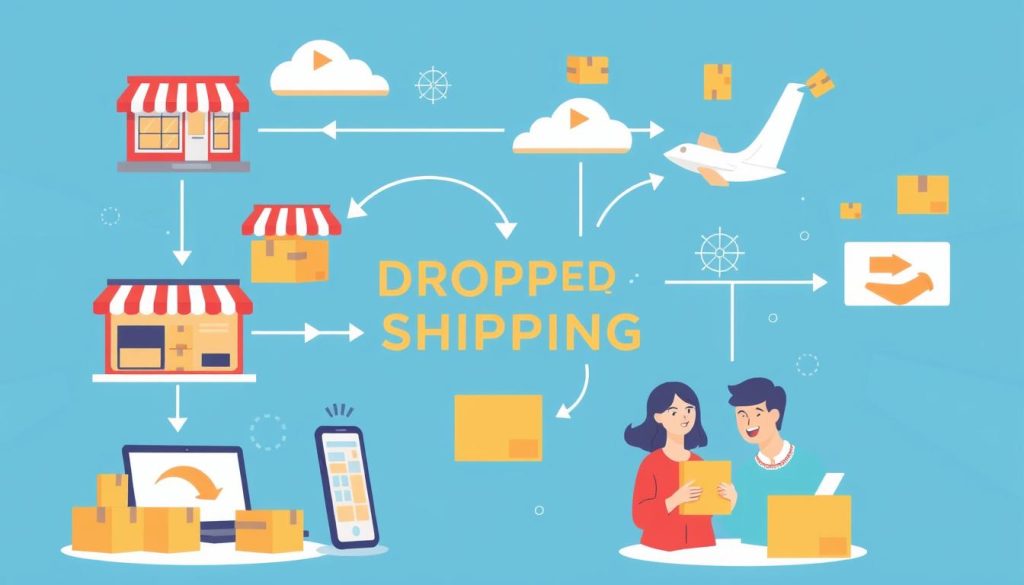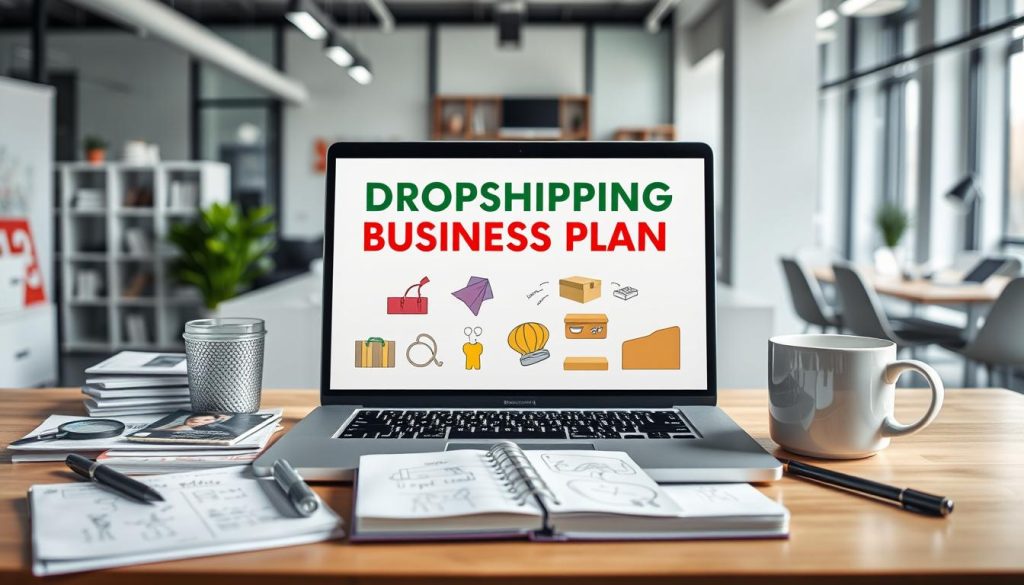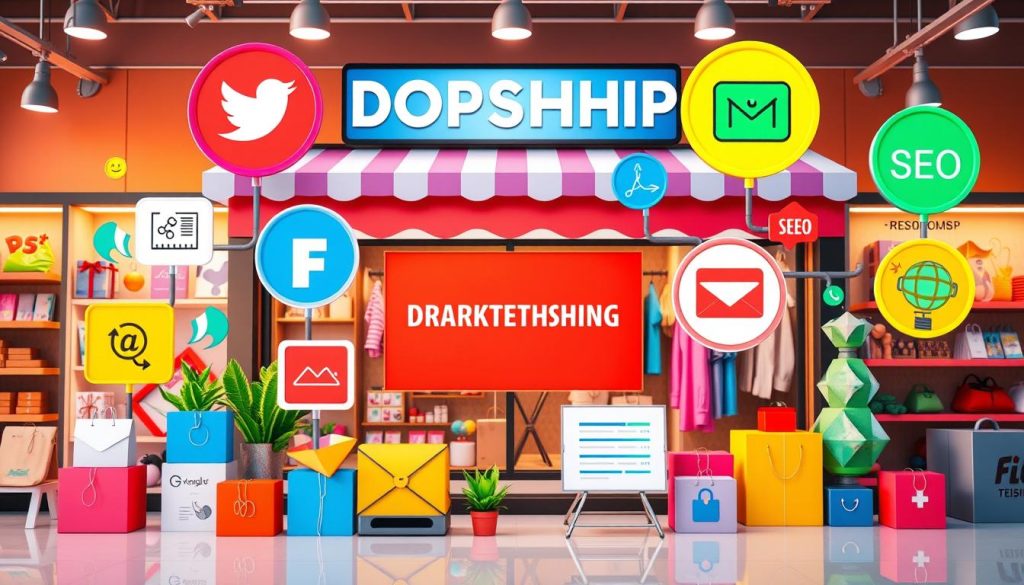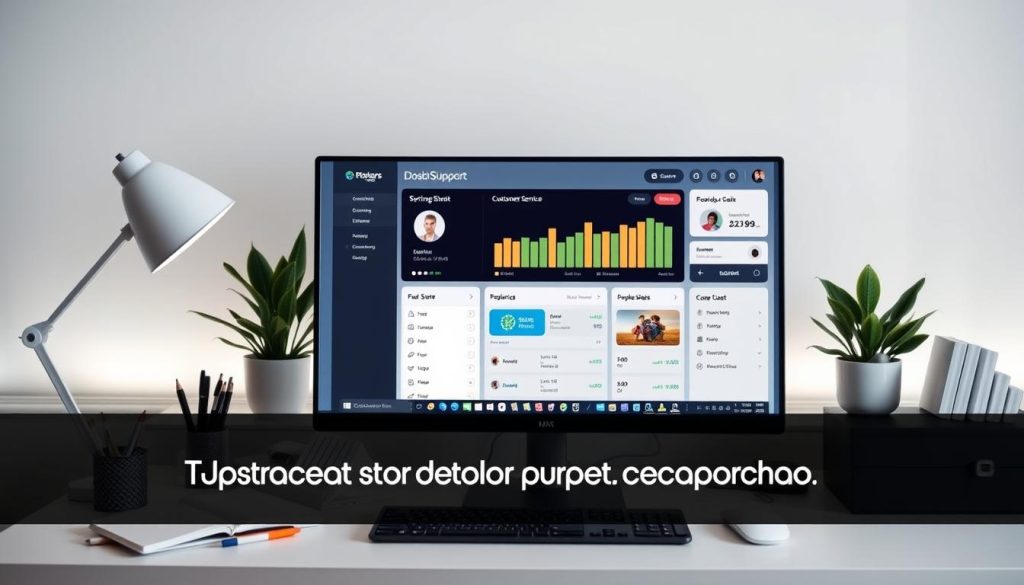The rise of e-commerce has created new chances for UK entrepreneurs. Starting a dropshipping business is a great way to begin with low costs. It’s perfect for those wanting to step into online retail. This guide will share key tips for dropshipping, helping you set up a successful business.
We’ll cover everything from finding your niche to marketing your products. Knowing what UK consumers want and the latest trends is crucial for success. Let’s explore the basics of dropshipping together.
Understanding the Dropshipping Business Model

The dropshipping model is a unique way to sell products online. Retailers sell items to customers without keeping any stock. They work with suppliers who send the products straight to the buyers. This makes it easier for entrepreneurs looking for flexible ways to run a shop.
Let’s look at the main points of how dropshipping works:
- Reduced overhead costs: Businesses save money because they don’t need to store products.
- Flexible product offerings: Shops can quickly change what they sell without worrying about leftover stock.
- Scalability: Dropshipping lets businesses grow fast with little extra money.
Dropshipping has its benefits but also has its challenges. It usually means making less profit than traditional shops. Managing relationships with suppliers is key. Also, businesses depend on suppliers for good quality products and quick delivery, which is important for happy customers.
Why Choose a Dropshipping Business in the UK?

The UK dropshipping benefits are many, making it a great choice for new entrepreneurs. The online shopping scene has grown a lot, thanks to more people buying online. This growth is a chance for dropshipping businesses to do well.
Starting a dropshipping business is easier and cheaper than traditional shops. You don’t need a lot of money to start. This lets entrepreneurs focus on growing their brand and marketing their products well.
The UK’s varied tastes offer many chances to find a special market. Dropshipping trends show more people want unique, custom products. If a business finds and meets these needs, they can attract more customers.
- Access to a thriving online market
- Reduced initial investment requirements
- Ability to tap into niche markets with diverse consumer needs
- Flexibility in business operations and product selection
Identifying Your Niche for Dropshipping

Finding a niche is key to a successful dropshipping business. A clear niche makes marketing easier and helps pick products that appeal to certain customers.
When researching your niche, try these steps:
- Use Google Trends to spot new trends and popular items. It shows what people are looking for.
- Look at social media. Join groups or forums about your niche to see what customers like.
- Analyse your competitors. Look at what other businesses in your niche are doing to find your edge.
Picking a niche that matches what customers want boosts your sales and loyalty. Knowing what the market wants and who you’re up against helps you market better. This makes your business more likely to succeed over time.
How to Research Suppliers for Your Dropshipping Business

Finding dropshipping suppliers can be tough for newbies. It’s important to look at several key factors when picking partners. You should consider product quality, shipping times, reliability, and how well they communicate. Working with reliable suppliers is key to your business’s success.
Starting with platforms like AliExpress and CJ Dropshipping can help you find suppliers. These sites offer a wide range of products and user reviews to help you trust suppliers. Directories such as Oberlo and SaleHoo also provide insights into trustworthy suppliers, making your search easier.
Good relationships with suppliers can lead to better prices and service. So, it’s wise to ask for product samples and see how quickly they respond to you. A careful approach to finding and checking suppliers is crucial for a successful dropshipping business.
Setting Up Your Online Store

Setting up an online store is a big step that affects how well it does and how happy customers are. It’s important to look at different e-commerce platforms to make a good choice. Shopify, WooCommerce, and BigCommerce are great for different kinds of businesses. Knowing about these options helps you start your online store well.
Selecting the Right E-commerce Platform
Choosing the right e-commerce platform is crucial for your online store’s success. Think about these things when comparing platforms:
- Ease of Use: Shopify is easy to use, perfect for beginners.
- Customisation: WooCommerce lets you personalise your site more.
- Scalability: BigCommerce is good for big businesses that are growing fast.
- Cost: Check the monthly fees and transaction costs to fit your budget.
Designing a User-Friendly Website
Good e-commerce website design makes users happy and helps you sell more. Important things for a user-friendly site are:
- Mobile Responsiveness: Make sure your site works well on phones and tablets.
- Intuitive Navigation: Make it easy for customers to find what they want.
- Effective Call-to-Action Elements: Use buttons and messages that encourage people to buy.
Creating a Business Plan for Your Dropshipping Venture

A solid dropshipping business plan is crucial for success. It serves as a guide, helping you navigate the dropshipping world and reduce risks. Your plan should cover market analysis, marketing, financial forecasts, and operational details.
When making your dropshipping business plan, think about these points:
- Market Analysis: Know who your customers are and how they act. Look at your competitors to see where you can stand out.
- Marketing Strategies: Plan how you’ll promote your products. This might be through social media, emails, or SEO.
- Financial Projections: Work out your initial costs, ongoing expenses, and how much you expect to make. This helps set realistic financial targets.
- Operational Plans: Explain how your business will work, including finding suppliers, fulfilling orders, and serving customers.
- Measurable Goals: Set clear, reachable goals. This makes it easier to see how you’re doing.
Using templates and examples can help you organize your ideas well. Strong entrepreneurial strategies boost your chances of success with your dropshipping business plan.
Marketing Strategies for Your Dropshipping Business

Effective dropshipping marketing strategies are key to success in a tough market. Using social media and email marketing can boost your sales. These methods help you reach more customers and grow your business.
Utilising Social Media for Promotion
Sites like Facebook, Instagram, and Pinterest are great for promoting your store. They help spread the word about your brand and get customers talking. Here are some tips to keep in mind:
- Make your content look good and show off your products.
- Target your ads to reach people who might like your stuff.
- Talk to your followers by running polls, contests, and chatting directly.
Good social media plans make your products easy to find. This brings more people to your store. Always check how well your campaigns are doing to make them better.
Email Marketing Tactics
Email marketing is still very important. It helps keep customers coming back and turning into buyers. Here are some key points:
- Get people to sign up for your emails with special offers.
- Send messages that feel personal by grouping your customers by interests.
- Write catchy subject lines and content to get more people to open your emails.
Knowing how to use email marketing well lets you talk to your customers better. This keeps your store in their minds. Always look at your email campaign results to see what’s working and what’s not.
Handling Customer Service in Your Dropshipping Business

Good customer service is key to a strong brand and keeping customers happy. People want quick answers to their questions. It’s important to handle their concerns and think ahead to prevent them.
Here are some tips for smooth customer service:
- Use CRM tools to make talking to customers easier.
- Set up automated answers for common questions.
- Be clear about returns and refunds.
Quick replies are vital for happy customers. They want fast answers, especially when it’s urgent. Good e-commerce support means personal talks to make customers feel valued. Listening to what customers say helps improve your services and shows you care about getting better.
Training your team well can make customer service better. Giving staff the right knowledge helps them handle different questions confidently. This not only makes customers happier but also helps your support team by reducing the number of big issues.
Understanding Legal and Tax Obligations

Starting a dropshipping business in the UK means you must follow certain laws and pay taxes. First, you need to register your business. You can choose from being a sole trader, a partnership, or a limited company. Each choice affects how you pay taxes and who is legally responsible.
VAT (Value Added Tax) is a big deal for taxes in the UK. If your business makes more than a certain amount, you must register for VAT. This means you’ll charge VAT to customers and file tax returns. It’s important to know the rules about VAT and dropshipping, especially when buying products from outside the UK.
Consumer rights laws are also key. You must follow UK laws to protect customers. This means giving correct product details, handling returns well, and keeping customer data safe. Sticking to these laws helps build trust with your customers.
If you don’t follow these laws, you could face big problems like fines and legal fights. It’s a good idea to get advice from experts to understand UK tax laws and dropshipping rules better.
Optimising Your Supply Chain Management

Effective supply chain management is key to a dropshipping business’s success. It’s vital to use strong inventory management techniques. This ensures stock levels are tracked well and prevents overselling. Using advanced tools and software helps in forecasting demand. This way, business owners can make smart choices about restocking and working with suppliers.
Inventory Management Techniques
Using new inventory techniques can make operations smoother. Here are some strategies to consider:
- Integrate inventory management software for real-time stock tracking.
- Set up alerts for when stock is running low to stop sales disruptions.
- Use demand forecasting tools to predict seasonal changes in product popularity.
- Apply batching strategies for efficient order fulfillment and lower holding costs.
Shipping Strategies to Enhance Customer Satisfaction
Efficient shipping solutions are also crucial for customer satisfaction. Here are some key strategies:
- Offer various shipping options to meet different customer needs and budgets.
- Be clear about delivery times to set realistic expectations.
- Keep customers updated with order confirmations and tracking information.
- Choose warehouse locations wisely to cut down on shipping distances and times.
Leveraging Analytics to Track Your Dropshipping Success

Success in dropshipping depends on making smart choices with data. By using dropshipping analytics, entrepreneurs can keep an eye on important performance indicators. These include sales, conversion rates, and how much it costs to get new customers.
Tools like Google Analytics give deep insights. They show what users do, helping dropshippers find the best marketing ways and products. Working with e-commerce platforms makes it easier to see how sales happen and helps in making smart decisions.
To track your business well, look at these key points:
- Sales figures: Keep an eye on total sales and look for trends to guess future performance.
- Conversion rates: See how many visitors buy something to check if your website and marketing work well.
- Customer acquisition costs: Work out how much it costs to get new customers, making sure you stay profitable.
By checking these metrics often, dropshipping business owners can tweak their plans and get better at what they do. Making decisions based on data leads to a smarter business plan and lasting success.
Best Practices for Pricing Your Products

Setting the right prices for your products is key to doing well in dropshipping. The way you price your items affects how customers see them and can change how many you sell. Knowing how to price your products can help you stand out from the competition.
Here are some common ways to price your products:
- Cost-Plus Pricing: This method adds a markup to the total cost of a product for profit. It makes sure you cover all costs and earn a profit.
- Competitive Pricing: Looking at what others charge helps you find a good price. Setting your price a bit lower than the competition can attract more customers.
- Value-Based Pricing: This pricing is based on how much customers value your product. Knowing what customers want helps you set prices that make you more money.
Discounts and promotions are important for pricing too. Offering special deals for a limited time can make your products seem more valuable and encourage people to buy. Finding the right balance between good prices and making a profit requires looking closely at your costs and the market.
Common Pitfalls to Avoid When Starting a Dropshipping Business

Starting a dropshipping business offers many chances but also has big challenges. Knowing about common mistakes is key to doing well.
Not doing enough market research is a big mistake. Many newbies pick products without knowing their audience or competitors well. Doing thorough research helps make smart choices and find profitable areas.
Choosing the right suppliers is also crucial. Working with unreliable suppliers can lead to bad products, late deliveries, and unhappy customers. Spend time checking out potential suppliers and setting up good communication to avoid these problems.
Customer service is often overlooked but is very important. Not answering customer questions or complaints can harm your reputation. Create a strong customer service plan to make customers happy and loyal.
Getting pricing right is also key. Newcomers often set prices too low to get sales or too high, which scares off customers. Look at your costs and what others charge to set fair yet profitable prices.
It’s important to have realistic goals when starting in dropshipping. Expecting challenges and being ready for them can reduce stress and disappointment. Learning from mistakes will improve your skills over time.
Scaling Your Dropshipping Business Effectively

Scaling a dropshipping business needs a careful plan for growth. It’s important to keep quality high while growing. To grow, consider adding more products to sell. This can draw in more customers.
- Explore new niches that align with current trends.
- Enhance marketing efforts through targeted advertising and social media engagement.
- Utilise automated tools for order processing and inventory management to streamline operations.
Going global can open up new chances for profit. Each country may need its own marketing and knows what customers like. It’s key to watch how you’re doing to make sure you’re not losing focus on customers. Keeping customer service top-notch builds loyalty. This is crucial for a dropshipping business to thrive over time.
The Importance of Building Customer Trust
In the competitive dropshipping world, building trust with customers is key. It boosts your brand’s reputation and keeps customers coming back. When customers trust their purchase choices, they’re more likely to stay with you, helping your business grow.
Using customer testimonials and honest reviews can change how people see your brand. Happy customers’ words of praise make others trust your products and service more. Being open about shipping times, product details, and return policies also builds trust with customers.
It’s also vital to offer secure payment options and clear return policies. This makes customers feel safe when they shop with you. With great customer service and top-quality products, you’ll not only keep customers loyal but also get them to come back, which is crucial for success in dropshipping.
















